THE FUTURE OF HOUSING
Three new houses built using 3D concrete printing technology could provide a solution to Ireland’s housing crisis
Earlier this summer Martin O’Brien, the Chief Executive of Louth and Meath Education and Training Board (LMETB), was presented with a miniature replica of the 3D houses in Dundalk that he helped make a reality. Justin Kinsella, Managing Director of Harcourt Technologies (HTL), presented Martin with the replica and said: “Martin O’Brien’s energy and vision were instrumental in making 3D concrete printed homes a reality in Ireland. We are delighted to recognise his contribution to this groundbreaking project.”
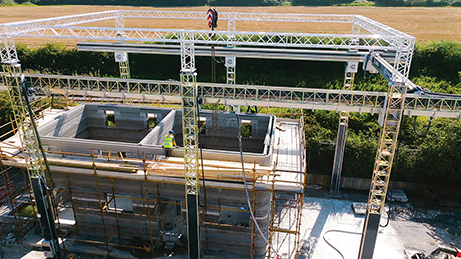
The three houses at Grange Close in Dundalk have been built using a 3D concrete printing machine which constructed the homes layer by layer over just two weeks. HTL, the design and build contractor on the project, used a gantry-mounted 3D concrete printer which extrudes concrete to create cavity walls without the need for traditional concrete blocks. “It’s like building a concrete block wall, but the machine lays 50mm layers instead of manual placement,” said Justin Kinsella, who also heads up Harcourt Architects.
“As architects and engineers, we design the building digitally and the model guides the printer to extrude the material layer by layer,” he said. The new homes in Dundalk have been built three times faster than traditional methods, shortening the construction timeline by 25-30% and using a third of the labour typically required. They are, says Martin, a testament to what can be achieved when forward-thinking ideas and collaborative efforts come together. Justin approached Martin and the team at LMETB about two years ago with the idea of building houses using 3D printed concrete. Immediately, Martin saw the potential of the disruptive technology. “It sounded like an innovative idea, but one that required a set of skills that at the time, weren’t available. We undertook to provide the necessary training in our Advanced Manufacturing Centre in Dundalk and purchased our own 3D concrete printer to facilitate training, which was a significant investment.” Given the scale of Ireland’s housing crisis, it was money well spent. “The Taoiseach has committed to building an additional 50,000 houses each year for the next five years. As an industry, we need to be innovative and come up with ways of meeting that target in a sustainable, energy efficient way. By utilising 3DCP (3D concrete printing), we’re closer to reaching that target.”
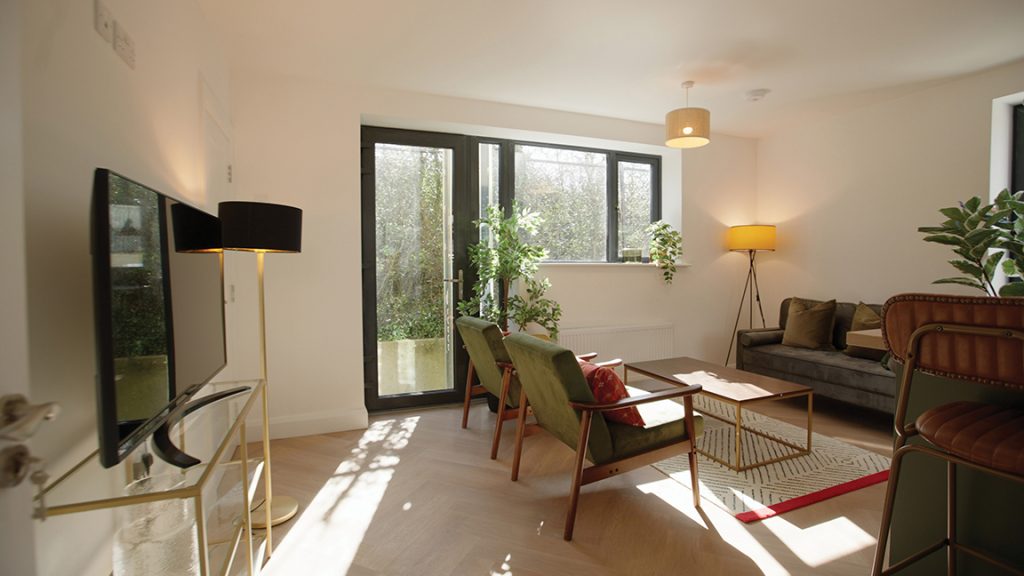
Exploring the potential of MMC
Justin established HTL Technologies in 2021 to investigate the potential of MMC around affordable housing. That same year, HTL partnered with construction printing solutions firm COBOD, who today supplies the technology used by HTL to build 3DCP homes. Over two years were spent on heavy R&D; sourcing materials suitable for printing that could also comply with local regulations was a task in itself. “We partnered with Roadstone on developing the required materials. It’s been a fantastic collaboration and we’re looking to develop that partnership further.” Once the HTL team determined how the process would work, it was all systems go. Before work began on the Grange Close site, HTL completed two 2-bedroom units at its R&D facility in Drogheda. “We wanted to show it could be done, that it’s fully compliant and that it’s a method that could easily be scaled up to a national level.”
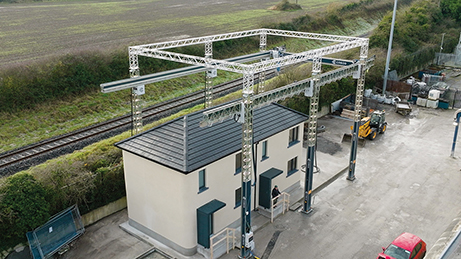
Speed of delivery
That initial demonstration paid off; LMETB is the first ETB to have purchased its own 3D concrete printer. An ongoing Skills to Advance subsidised training programme gives those working in construction-related sectors access to upskilling opportunities with the innovative technology.
To date, over 100 people have completed training. “We have a wide range of people signing up for the programme. We’re also getting a lot of queries from traditional building contractors, architects and local authorities and also from people in the industry that have reached a stage in their career where they’re looking for something less labour intensive,” says Martin.
Martin approached Louth County Council with the idea of using 3DCP to deliver social housing in a fast, efficient way. From the off, the Council was extremely positive. It had already identified the need for social housing; the speed at which 3DCP could deliver these houses was an attractive proposition. “Each machine can produce 80 airtight, climate friendly houses a year. In my view, these houses are more airtight than a brick-built house and five times stronger than a block-built house. They’re built to a 5mm tolerance, they’re fire-resistant and they have a 100 plus year expected life cycle. The way in which the concrete is laid out and the fact that it’s mass concrete as opposed to concrete block make them more sustainable. This method of construction also reduces waste, there’s accurate material placement and in terms of carbon embodiment, these houses are comparable with timber frame,” says Martin.
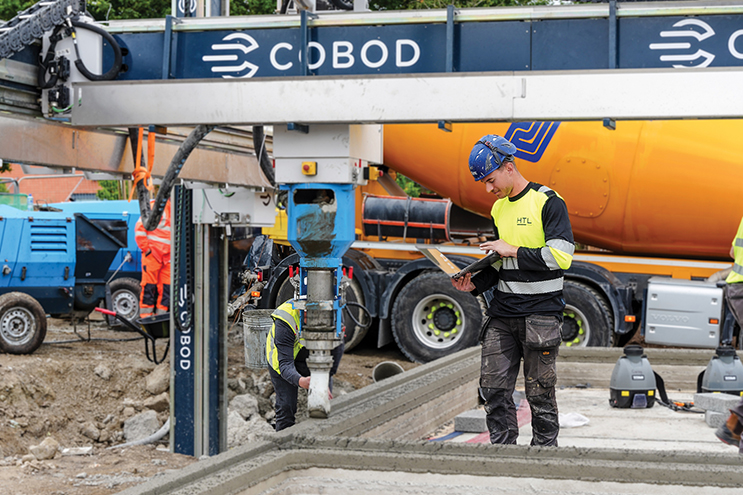
Producing low carbon embodied concrete is a priority, says Justin.“People often think of concrete as quite a heavy carbon embodied material, but we’re working to make the product as sustainable as possible. The mix that we developed at Roadstone is the lowest carbon embodied mix in the world. Airtightness is also a key feature. The fact that you can build a house like this in eight to 10 days is incredible.”
The local authority provided the site at Grange Close in Dundalk. Now complete, three families on the Council’s social housing list are due to move in. 3DCP represents a potential solution to the housing crisis.
“Obviously you’re always cautious with new technology before you see success in the longer term, but I believe that up to 15-20% of Irish homes could be constructed using 3DCP in the future. It might take up to 10 years – it will be a slow liftoff I would imagine. The public won’t make up their minds about these houses until a number of them are built around the country. Once that happens, I think we will see a more widespread adoption,” says Martin.
Demystifying 3DCP
Using 3DCP for larger developments would allow for greater economies of scale, but what are the challenges to that scaling up? “Like any new technology, it has to be desmystified for people. Explaining the concept and the process can be difficult and even the name 3D concrete printing can be hard for people to understand. Last year, the NSAI adopted a new regulation called Additive Construction, which covers 3D concrete printing. I think it’s a better name and perhaps one that people will understand a bit easier,” says Justin. Clearly demonstrating the benefits of 3DCP and making a compelling case for it will pave the way for its widespread adoption, he says.
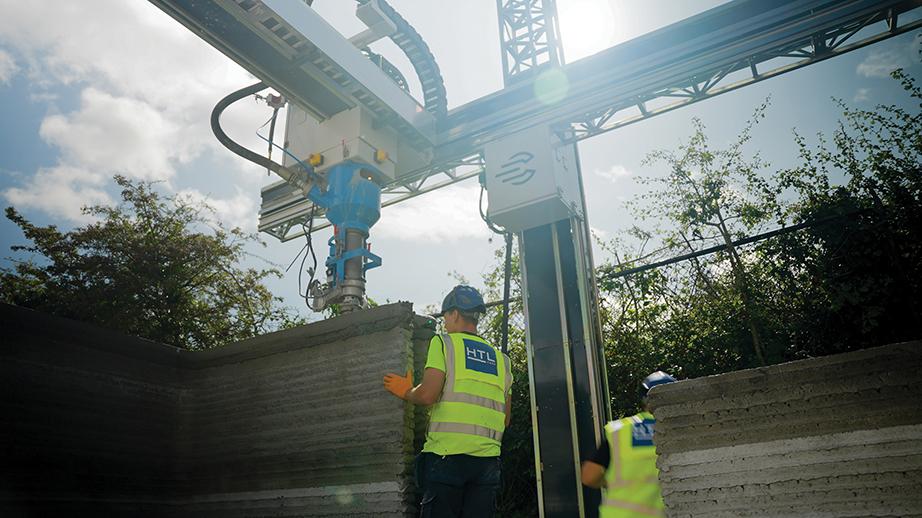
“We’re working very hard to make sure we exceed what we actually state we’ll do and I think we’re succeeding. A number of local authorities have been to the Grange Close site who have expressed their interest in the technology.”
HTL is currently in the process of selecting the next project for its 3DCP technology. “We’re looking at five projects across Donegal and Leinster and we hope to announce our next project within the next couple of months. We’re also working with Roadstone to make detail on the printed concrete even more efficient.”
_____________________________________________________
Michael McDonnell Managing Editor of Irish Construction Industry Magazine & Plan Magazine
Email: michael@irishconstruction.com WWW.MCDMEDIA.IE